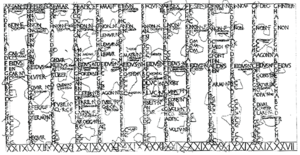 Global Information
Global InformationRoman calendar information


The Roman calendar was the calendar used by the Roman Kingdom and Roman Republic. Although the term is primarily used for Rome's pre-Julian calendars, it is often used inclusively of the Julian calendar established by the reforms of the Dictator Julius Caesar and Emperor Augustus in the late 1st century BC.[a]
According to most Roman accounts, their original calendar was established by their legendary first king Romulus. It consisted of ten months, beginning in spring with March and leaving winter as an unassigned span of days before the next year. These months each had 30 or 31 days and ran for 38 nundinal cycles, each forming a kind of eight-day week—nine days counted inclusively in the Roman manner—and ending with religious rituals and a public market. This fixed calendar bore traces of its origin as an observational lunar one. In particular, the most important days of each month—its kalends, nones, and ides—seem to have derived from the new moon, the first-quarter moon, and the full moon respectively. To a late date, the College of Pontiffs formally proclaimed each of these days on the Capitoline Hill and Roman dating counted down inclusively towards the next such day in any month. (For example, the year-end festival of Terminalia on 23 February was called VII. Kal. Mart., the 6th day before the March kalends.)
Romulus's successor Numa Pompilius was then usually credited with a revised calendar that divided winter between the two months of January and February, shortened most other months accordingly, and brought everything into rough alignment with the solar year by some system of intercalation. This is a typical element of lunisolar calendars and was necessary to keep the Roman religious festivals and other activities in their proper seasons.
Modern historians dispute various points of this account. It is possible the original calendar was agriculturally based, observational of the seasons and stars rather the moon, with ten months of varying length filling the entire year. If this ever existed, it would have changed to the lunisolar system later credited to Numa during the kingdom or early Republic under the influence of the Etruscans and of Pythagorean Southern Italian Greeks. After the establishment of the Republic, years began to be dated by consulships but the calendar and its rituals were otherwise very conservatively maintained until the Late Republic. Even when the nundinal cycles had completely departed from correlation with the moon's phases, a pontiff was obliged to meet the sacred king, to claim that he had observed the new moon, and to offer a sacrifice to Juno to solemnize each kalends.
It is clear that, for a variety of reasons, the intercalation necessary for the system's accuracy was not always observed. Astronomical events recorded in Livy show the civil calendar had varied from the solar year by an entire season in 190 BC and was still two months off in 168 BC. By the 191 BC Lex Acilia or before, control of intercalation was given to the pontifex maximus but—as these were often active political leaders like Caesar—political considerations continued to interfere with its regular application. Notably, intercalation had to be personally announced by the chief pontiff in Rome so, when his war in Gaul and civil war against Pompey kept Caesar out of the city for years at a time, the calendar was repeatedly left unadjusted.
Victorious in civil war, Caesar reformed the calendar in 46 BC, coincidentally making the year of his third consulship last for 446 days. This new Julian calendar was an entirely solar one, influenced by Egypt's. In order to avoid interfering with Rome's religious ceremonies, the reform distributed the unassigned days among the months (towards their ends) and did not adjust any nones or ides, even in months which came to have 31 days. The Julian calendar was designed to have a single leap day every fourth year by repeating February 24[b] (a doubled VI. Kal. Mart. or ante diem bis sextum Kalendas Martias) but, following Caesar's assassination, the priests mistakenly added the bissextile (bis sextum) leap day every three years due to their inclusive counting. In order to bring the calendar back to its proper place, Augustus was obliged to suspend intercalation for one or two decades.
At 365.25 days, the Julian calendar remained slightly longer than the solar year (365.24 days). By the 16th century, the date of Easter had shifted so far away from the vernal equinox that Pope Gregory XIII ordered a further correction to the calendar method, resulting in the establishment of the modern Gregorian calendar.
Cite error: There are <ref group=lower-alpha> tags or {{efn}} templates on this page, but the references will not show without a {{reflist|group=lower-alpha}} template or {{notelist}} template (see the help page).